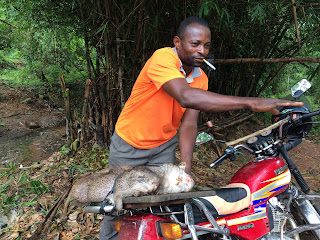
Christlia
Nguidzi is a park ranger on a conservation mission – and the only female on a
team of 20 rough-and-tumble rangers. Single, 23 years old, 52 kilos, she rattles on
about face-to-face encounters with hippos, gorillas, snakes and angry
villagers. ‘Our training was tough! Paramilitary boot camp followed written
exams about conservation laws and wildlife. I came in first place in target
practice! Older, stronger men dropped out but I’m still here and proud to be
making a contribution.’
She works
in the Lac Tele Community Reserve which was created in 2001 to manage the
area’s biodiversity-rich flooded savanna forest. I met Christlia at park
headquarters in Epena while on mission to lend environmental governance support
to the park’s community development team.
The Reserve is located in the
Republic of Congo just across the Lac Tumba Reserve in the Democratic Republic
of Congo – the area constitutes the
world’s largest peatland. The American
environmental NGO
Wildlife Conservation Society manages it in tandem with the
Congolese agency for nature conservation (ACFAP).

Population density is low – less than three inhabitants per square kilometer – which facilitates conservation efforts. Local communities in the reserve draw their subsistence mainly from fishing, and depending on the season, from hunting and farming. Harvesting of non-timber forest products such as caterpillars and mushrooms contribute to diets in the lean months from July to September when fish is scare. Dugout canoes, fishing nets, woven-rattan traps and harpoons are the symbols of community life. Other than selling fish and bushmeat, economic activities are limited, so families survive largely outside of the cash economy.
Interviews
with villagers in the reserve revealed a common litany. ‘How are we supposed to get money to pay our kids’ school fees if we don’t hunt and fish? The reserve managers promised development options but so far haven’t delivered anything.’
There is indeed a pattern of frustration that started with skepticism but has
mutated into anger. WCS is promoting cacao production but villagers admit that
between the painstaking growing of cacao and hunting, the economic choice is
simple: ‘we only get 600CFA for a kilo of cacao whereas a duiker can fetch five
times as much’.
A day in
the life of a park ranger is physically and emotionally exhausting. ‘A patrol
can last up to three weeks in the forest. I carry a gun and a heavy pack filled
with cans of sardines and corned beef, my tent, GPS and satellite phone in case
we have an emergency. We go days and days without washing up – and that’s no
joke. It’s never happened to me but colleagues have met up with family members
with guns and animals that are on our country’s protected species list. What
are they supposed to do? Uphold their conservation mandate or get into trouble
with the family?’ Tasks in this mandate according to Christlia are
anti-poaching, wildlife tracking and stimulating community awareness.
There work is also dangerous. The 12 caliber shotgun is another
symbol in these parts. ‘I was really scared the day we found a pygmy hunter
with three elephant tusks and a gun. There are networks controlled by
influential people in the big cities behind elephant poaching. Another day,
angry villagers threw sticks and stones at us because we arrested a local poacher.’
Christlia
has the support of her family in her commitment to work as a ranger. ‘My nieces
think I’m doing something amazing and want to follow in my footsteps. I really
hope they will succeed. We need more independent women to do this work so they
won’t rely on their husbands.’
She is one of six children so her parents are
grateful she can send some money at the end of the month. Her father is a
school gym teacher and her mother sells fish and banana at the market in
Impfondo. She says her earnings are low and complains that only five rangers
have government contracts. ‘Most of us are paid by WSC. What’s going to happen
to us when the project money dries up?’ But, she adds, with a smile: 'I'm content to carry on. God gives me the courage to do so, and anyway, I don’t
really have a choice.’
 |
| Flooded savanna is the dominant ecosystem of the Lac Tele Community Reserve |
 |
| Sign posts serve to showcase partner logos |
 |
Grill used to smoke fish
|
 |
| Fishing traps |
 |
| Fishing camp near Bokatola |
 |
| Harpoons are indicators of the presence of large fish |
 |
Dugout canoes are the main means of tranportation in these flooded grasslands
|
 |
| Solar panels help villagers charge cell phones and listen to the radio |
 |
fishing trap
|
 |
| Park managers support local development structures |
 |
| local visionnaries contribute to forest conservation in their own way |
 |
African bush plum is an important contribution to the local diet during the lean months
|






















































































